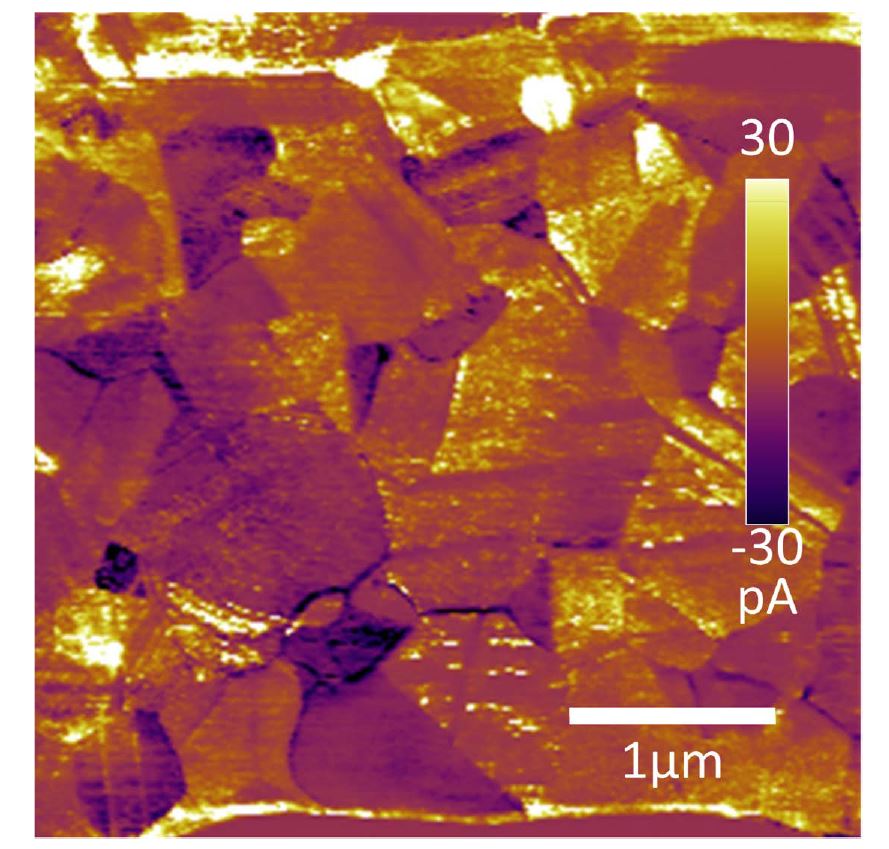Read how Nanoworld Arrow-EFM AFM probes were used in the paper “Ferroelectric domains and phase transition of sol-gel processed epitaxial Sm-doped BiFeO3 (001) thin films” in which the authors Zhen Zhou, Wie Sun, Zhenyu Liao, Shuai Ning, Jing Zhu and Jing-Feng Li:
- prepared 12% Sm-doped BiFeO3 epitaxial thin films on Nb-doped SrTiO3 (001) substrate via a sol-gel method
- used PFM (piezoresponse force microscopy) to characterize the in-situ ferroelectric domain evolution from room temperature to 200 °C
- illustrated a phase transition from ferroelectric to antiferroelectric phase by SS-PFM and found a significant piezoelectric response at the phase boundary
Their work revealed the origin of the high piezoresponse of Sm-doped BiFeO3 thin films at the morphotropic phase boundary (MPB).*
A PtIr-coated NanoWorld Arrow-EFM cantilever with a nominal spring constant of 2.8 N/m and a typical resonant frequency of 75 kHz was used in all imaging modes mentioned in the article.

*Zhen Zhou, Wie Sun, Zhenyu Liao, Shuai Ning, Jing Zhu, Jing-Feng Li
Ferroelectric domains and phase transition of sol-gel processed epitaxial Sm-doped BiFeO3 (001) thin films
Journal of Materiomics, Volume 4, Issue 1, March 2018, Pages 27-34
DOI: https://doi.org/10.1016/j.jmat.2017.11.002
Please follow this external link if you would like to read the full article: https://www.sciencedirect.com/science/article/pii/S2352847817300631
Open Access The article “Ferroelectric domains and phase transition of sol-gel processed epitaxial Sm-doped BiFeO3 (001) thin films” by Zhen Zhou, Wie Sun, Zhenyu Liao, Shuai Ning, Jing Zhu and Jing-Feng Li is licensed under a Creative Commons Attribution 4.0 International License, which permits use, sharing, adaptation, distribution and reproduction in any medium or format, as long as you give appropriate credit to the original author(s) and the source, provide a link to the Creative Commons license, and indicate if changes were made. The images or other third party material in this article are included in the article’s Creative Commons license, unless indicated otherwise in a credit line to the material. If material is not included in the article’s Creative Commons license and your intended use is not permitted by statutory regulation or exceeds the permitted use, you will need to obtain permission directly from the copyright holder. To view a copy of this license, visit http://creativecommons.org/licenses/by/4.0/.


![Figure 1 from "Ferroelectric Domain Studies of Patterned (001) BiFeO 3 by Angle- Resolved Piezoresponse Force Microscopy": Patterned mesas are separated from the continuous film by lithography, as shown in the AFM topography image. (b) Schematic drawing of the atomic structure of BFO with angle-resolved polarization models. The Fe (red sphere) atom can be displaced towards twelve possible polarization orientations with respect to its centrosymmetric position. (c) AR-PFM domain map of a 1.2 × 1.2 μm2 area of unpatterned BFO film, corresponding to the black dashed area in (a). (d) The area distribution of each polarization variant according to angle relative to the [100] direction. (e) The average area of stable and meta-stable polarization variants.](https://dhipgo7nn2tea.cloudfront.net/wp-content/uploads/2018/01/10172613/Figure_1_from_Ferroelectric_Domain_Studies.jpg)